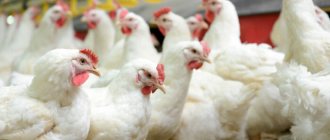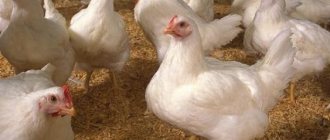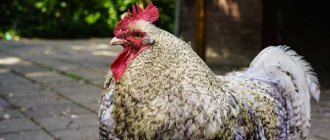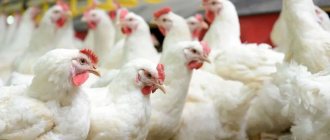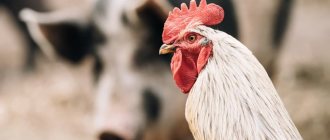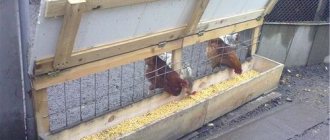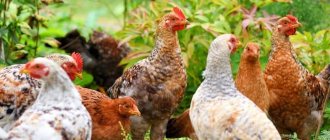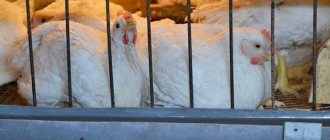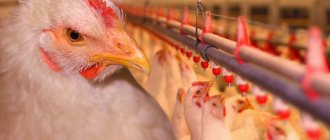2 515
no comments yet
3
Author:
Rasskazov Pavel.
Reading time: 10 minutes
Raising broilers is a highly profitable enterprise if done correctly. In order not to incur extra costs, you need to know how many days you can feed the bird and when it should be slaughtered.
Cooking at home
Many poultry farmers do not trust industrial feeds too much and prepare mixtures for feeding broilers themselves. In addition, it is much more profitable than purchasing a finished product. Preparing feed at home also requires purchasing grain and other ingredients, which should only be purchased from reliable sellers. With low-quality grain, harmful pesticides and other components that can lead to the death of young animals can enter the food of chickens.
Start: quantity according to the table for cooking
To feed chickens at the initial stage of growth, you can prepare a mixture consisting of the following components:
- crushed corn – 50%;
- crushed wheat grain – 16%;
- sunflower cake – 14%;
- barley – 8%;
- low-fat kefir – 12%.
Kefir contains vitamins and lactic acid bacteria, which are very useful for small chickens. Due to the presence of a liquid and perishable fraction, such food should be prepared in small portions and not left in the feeder for a long time. You can slightly reduce the amount of corn and add fishmeal instead. Some recipes may contain small amounts of yeast, but experts say it should not be given to the smallest chickens. The chickens are fed every two hours.
You can learn how to build a brooder with your own hands here.
This food is primary and contains a large amount of protein, which is essentially a building material for a young body. Starter feed can be used from the first days of life.
Chicken growth: how much feed to give
After broilers reach 14 days, the composition of the feed changes slightly. Many poultry farmers add the ingredient BVMK, which is a protein-vitamin-mineral concentrate, to the feed mixture at the chicken growth stage. Growth feed for broilers may have the following composition:
- crushed corn – 48%;
- sunflower cake – 15%;
- wheat grain – 8%;
- ground barley – 6%;
- fish or meat flour – 7%;
- herbal flour – 3%;
- yeast – 2%;
- fish oil – 1%;
- chalk – 1%;
- sodium chloride – 0.1%;
- BVMK ten percent - 10%.
The concentrate can be 5% or 10%, which should be taken into account when preparing the mixture.
Finish elite
Starting from 30 days, broilers should be transferred to finishing elite feeding. During this period, the chickens are already large enough and grains can be fed without crushing. In addition, fresh vegetables and herbs should be added to the feed, which is absent in industrial feed. The composition of the finishing feed may vary within small limits, but the basic composition will look like this:
- corn – 45%;
- sunflower cake – 15%;
- fresh vegetables and herbs – 12%;
- wheat – 10%;
- barley – 8%;
- feed yeast – 5%;
- fishmeal – 5%;
- chalk, crushed shells or limestone – 5%.
Many poultry farmers add sprouted grains to the finishing feed. This product contains many biologically active substances that stimulate good digestion and active weight gain. This mixture contains a reduced amount of protein components, since in older chickens it is no longer so important.
However, this feed contains more minerals and vitamins, which allows for proper care and a longer life expectancy for the bird. Read about how to build broiler cages with your own hands here.
Packing carcasses
GOST voices the following parameters for the selection of meat products:
- visual assessment of the carcass;
- broiler age;
- temperature;
- type of processing;
- degree of fatness.
The age of a broiler is determined by the hardness of the keel: in young birds it is not yet ossified, while in adult birds it is absolutely hard.
Chilled carcasses should have a temperature of 0 to 4 degrees, ice cream - no more than -8 degrees.
Processing methods for meat products are divided into: complete evisceration, semi-evisceration and evisceration with a neck and a full set of giblets. Semi-gutted carcasses do not have a head, second and third cervical vertebrae, all internal organs, and skin up to the shoulders inclusive. The only thing left in the bird is the fat from the lower belly area. Gutted carcasses have a set of processed giblets, which are packaged in cellophane and sold separately: heart, stomach, liver.
Processed carcasses are divided into 2 categories. The first group includes birds with well-developed muscles, a rounded chest and a non-protruding keel, with a small amount of subcutaneous fat deposited. Birds of the second category have a not very developed muscle system, a prominent keel and no subcutaneous fat.
All carcass shipments must always be inspected by a veterinarian. Without stamps, they will be packed in polymer film, onto which labels will be stuck.
Before packing the carcass, it is carefully formed. If the broiler is gutted, the skin of the neck is secured under the wing, both wings are pressed to the sides. In semi-gutted carcasses, the neck and head are pressed to the body, the wings are pressed to the sides. A special device allows you to pack poultry in both vacuum and regular packaging. When a packaged broiler carcass is frozen, its live weight decreases by approximately 1.5%.
Broiler feed
Broiler
It is important for poultry farmers to know how much feed they need to raise a broiler at home. Feed consumption by age and estimated live weight gain
Feed consumption by age and estimated live weight gain
| Chick age | 1 day – 2 weeks | 2 weeks –1 month | 1–1.5 months |
| Feed consumption (g) | 15-80 | 80-120 | 120-180 |
| Average weight | 40 g-0.5 kg | 0.5-1.6 kg | 1.6-2.5 kg |
| Average growth (years) | 30 | 48 | 55 |
On a note. The proportion of water and feed in the birds’ diet is 1.7:1.
Liquid requirement:
- freshness;
- purity;
- no higher than 18...22 °C.
For the effectiveness of the diet, it is important to remember the age of the bird. To understand how much feed a broiler eats before slaughter, you will need a table
It shows the number of chickens per day. The table allows you to control the standards for the successful rearing of birds.
Feeding broiler chickens
Within 5 days, the chicks consume 15 g of feed. After 5 days, the dosage is increased to 20 g. Starting from day 11 to 20, 45 g of feed is consumed daily. Then every 2 weeks the amount of feed increases by 20 g. A one-month-old chick eats 120 g.
The nutrition table and visual information will make it easier to calculate your diet.
Amount of feed, depending on the age of the chicks
| Age, days | Feed, Mr. |
| 01.05.2018 | 15 |
| 06.10.2018 | 20 |
| 01.11.2020 | 80 |
| 21-30 | 120 |
| 31-45 | 180 |
| 46-60 | 220 |
After a week, the chickens are transferred to five feedings a day. At the age of 1 month and until the broilers are slaughtered, fattening twice a day is suitable.
Attention! Eating feed determines how long a broiler grows at home before slaughter. The intensity of fattening young animals is determined by the age of the chickens
They focus on slaughter feed for broilers at the final stage of rearing.
Broiler diet
Chickens need a balanced diet. To gain weight, mash is used, as well as dry food in granules.
The mash contains whey or milk, as well as mixed feed. Meat broth is good. 0.5 liters of water is given per 1000 g of dry chicken feed. The product sours quickly. An hour after feeding, remove any leftover food and wash the dishes.
The feed contains the following ingredients:
- oats and wheat;
- fishmeal and corn;
- table salt and barley;
- cake
The age of the bird affects the set of components.
Chicks have an acute reaction to a deficiency of vitamins in food. Broilers systematically need special vitamin supplements.
Vitamins A and E appear on the menu on the 5th day. This is followed by the addition of ergocalciferol. The following ratio is followed: for 10 ml of D2 0.5 l of vegetable oil. Storing the mixture in the refrigerator. Feed the chicks 2 times a week, adding 1 tsp. drug per 1000 g of feed.
Grass feeding
Attention! Broilers are not fed greens immediately after hatching. It is advisable to mow the grass before feeding
Oat and barley flour along with yogurt are mixed into the greens
It is advisable to mow the grass before feeding. Flour from oats and barley along with curdled milk is mixed into the greens.
Chopped grass is fed to the birds from the 5th day, 3 g are spent on the broiler daily. After a couple of days, the standard increases to 5 g, but no more.
Greens that benefit chickens:
- sorrel and radish foliage;
- plantain and onion feather;
- peas and chickweed;
- dandelions and lettuce;
- quinoa and garlic stalks.
Herbs containing many useful substances are required for the growth of broilers. Plants are selected carefully for fear of poisoning the chickens.
Greens for chickens
Toxic plants:
- burdock and potato flowers, foliage;
- white acacia and tomato branches;
- horse chestnut and elderberry;
- juniper, leaves and pear seeds.
On a note. Knowledge of herbs will allow private owners to avoid risks when feeding and not worry about reducing the growth parameters of meat chicken breeds.
Meat yield at slaughter
When slaughtering birds, the following techniques are used:
- external: a 2 cm long incision is made with scissors at the bottom of the ear, bleeding the carcass takes 2 minutes;
- internal: the scissors are inserted into the chicken’s beak, and the vessels above the tongue are cut at the junction of the veins: the jugular and the pavement.
Important! Correct organization of broiler slaughter affects product quality and shelf life.
Plucking of the carcass is carried out in water, which is heated to +60…+70 °C. Complete processing manually. Half gutted on a special table.
The yield of chicken meat is determined by the ratio of the weight of chicken to the pre-slaughter weight of chicken as a percentage. For semi-gutted chicken carcasses, the yield of broiler meat from live weight is 81.8%.
On a note. Chicken meat is called fresh meat if immediately after slaughter the temperature in the thickness of the muscles is +25 ° C or higher. When the temperature varies from 0 to +4 °C, it is a refrigerated raw material. At a temperature of 8 °C we are talking about a frozen product.
In broilers, the slaughter weight is determined by the processing of the carcass: in uneviscerated chickens it is the highest, because it contains a mass of bloodless and plucked individuals with fat, paws, head, and in addition includes internal organs. The weight of a semi-gutted chicken includes the carcass with fat, but without the intestines.
If chickens are completely gutted, they get rid of:
- intestines and blood;
- down and feathers;
- head and internal organs;
- wing to the elbow joint and legs.
Interesting. The slaughter yield of a chicken carcass is 60%.
The growth of broiler breeds depends entirely on the diet and rearing conditions. When raising birds, certain periods are observed when the chickens gain weight. Broilers are distinguished by their efficiency in terms of the ratio of feed to live weight. Poultry farmers use specific nutritional plans to minimize the cost of purchasing feed and increase the growth of broiler meat on private farms. The correct menu, according to the recommendations, will allow you to enjoy chicken after 2 months.
4.7 6 votes
Article rating
The relationship between nutrition and weight gain
Advice
Crosses are specially created for producing marketable meat carcasses. And in order for broilers to grow quickly, they provide the livestock with complete feed, proteins, vitamins and microelements.
It is recommended to use a scheme for raising young animals, which includes four fattening periods.
First
The pre-launch period falls on the first week of broiler life. Feed is given 8 times a day, at the rate of 20 g of food for each chicken.
In addition to pre-start feed, chopped boiled eggs, oatmeal, and low-fat cottage cheese are fed. Weight gain per day is at least 15 g. At the end of the first stage, the weight of the chickens is about 115 g.
Second
The starting period starts from 6 to 20 days. Reduce the number of feedings to 5 per day. But they increase the portion from 50 to 80 g per chicken.
Weighing shows a weight gain of at least 30 g per day. By the end of the period, young animals weighing 650 g are obtained.
It is allowed to feed ad libitum, bringing the amount of corn to 45% of the total feed. The young animals are given grated carrots and pumpkin, greens, bone, fish and grass meal, yeast, meal, and animal fat.
Third
The fattening stage lasts up to 40 days. With proper feeding, the bird gains about 55 g per day. Therefore, chickens at the final stage weigh 2.1 kg.
Each bird is given 150 g of feed 4 times a day, feeding the young with boiled potatoes, fish, yeast, grain crops, chalk and premixes.
Fourth
At the final stage before slaughter, each broiler is given 170 g of feed twice a day. They provide food in abundance, switching the livestock to whole grains, green mass and succulent feed. Feeding allows you to get carcasses of 2.5 kg.
To gain weight, it is recommended to ensure the supply of microelements and minerals, and not to skimp on high-quality feed and vitamin supplements.
Detailed recommendations for preparing a diet are described in the article “Feeding standards for broilers.”
Complete feed for broilers
Below is a table that shows the daily amount of feed for one individual and the level of growth of the chicken, in kg. Thanks to this data, you can calculate how much one individual consumes.
Table 1.
| Broiler age | Live weight, kg | Amount of feed, g/day |
| 1 Week | 0,166 | 29 |
| 2 week | 0,427 | 63 |
| 3 week | 0,846 | 104 |
| 4 week | 1,350 | 138 |
| 5 week | 1,925 | 168 |
| week 6 | 2,527 | 193 |
| week 7 | 3,091 | 204 |
| 8 week | 3,599 | 207 |
The table provides approximate consumption data, but the bird’s growth rate will directly depend on the type of feed and feeding intensity.
There are two ways to feed broilers, depending on the growing conditions of the birds:
- At large poultry factories I use complete feed
- At home, birds are fed dry mixture and wet mash.
In this case, individuals are fed in three stages: pre-start, start and finish. Depending on the period, the diet is changed.
https://www.youtube.com/watch?v=subscribe_widget
The first stage, pre-launch, begins on the first day of the chicks’ life and lasts a week. During this period, they are given grain crops: corn, wheat, oats, barley. They should make up at least ¾ of the total feed in the daily diet. The remainder consists of: soybean meal (14%), dry skimmed milk (12%) and premixes, which contain all the necessary vitamins and minerals to maintain the broiler’s immunity; they can be given as much food as they want, but approximately stick to the norm.
He eats a lot of food at one time, but it’s not worth saving. With proper feeding, broilers can gain weight from 1.5 kg to 2 kg during this stage. Chickens must first be fed 8 times a day, then gradually reduce the amount of food they eat to 2 times a day. But be sure to ensure that the bird’s growth rates do not decrease sharply.
At the final stage (starting from week 28), the diet for poultry is as follows: 45% corn and 10% wheat, sunflower meal 19%, bone meal 2%, feed yeast - 5%, fish meal - 3%. As at the starting stage, chickens must be fed with premixes, chalk, table salt and animal feed fat.
Tips for gaining weight
Content adjustment:
- Equipment for an insulated poultry house. The herd is kept on a thick layer of bedding or in cages. It is highly undesirable to equip a walking yard where the bird feels uncomfortable.
- Remove damp bedding regularly to prevent mold from growing on the floor. High humidity causes indigestion.
- The air temperature during the first week of chickens’ life should not fall below +30°C. As the livestock matures, the indicators are reduced to +20°C.
- The lights in the room are never turned off. It is advisable to use dim light and paint the lamps red to avoid outbreaks of cannibalism.
- The poultry house is promptly cleared of excrement and internal surfaces and equipment are disinfected.
- The bird is sensitive to ammonia fumes, so ventilation or vents are installed to ventilate toxic substances.
- Place basins with an ash-sand mixture for bathing chickens. This is how they get rid of parasites on their own.
If the housing conditions are met, and the chickens look sick, it is advisable to introduce food additives into the diet. For example, Chiktonik, the use of which is described in the article “Instructions for using Chiktonik for chickens.”
Feeding ration
The simplest feeding scheme for broilers, which is suitable for novice poultry farmers, involves feeding them with ready-made mixed feed: up to 30 days - starting feed, from a month until slaughter - finishing feed. The protein level in the starting stage of feeding should be 23%, in the finishing stage it should be less - 21%.
A slightly more complex scheme is feeding with 3 types of compound feed: up to 3 weeks of age - starter compound feed, the next 2 weeks - growth feed, from 35 onwards - finishing feed. With 3-period feeding at the start, the level of crude protein in the chicks’ diet should be 23%, during the growth period - 21% and in the finishing period, respectively, 20%.
But it is best to feed broilers at home for rapid growth and weight gain according to a four-stage scheme that most fully meets the needs of meat cross chickens. In this case, the feed for broiler chickens will be mixed feed of different types.
From 0 to 5 days
This stage is the most important in fattening broilers for meat in the household. Chicks that have recently hatched from the egg must have their digestive system adjusted, so they must be given special mixtures designed for chicks of this age.
To feed broiler chickens, pre-start feed (PK-5) is used, adding a little skimmed milk powder or milk, also dry in an amount of 3–5% (thanks to these additives, the broilers’ need for all essential amino acids is satisfied). In this feed, all nutrients are in high concentration, are highly soluble in water and are easily processed in the digestive tract of chickens. It contains cereals with a high content of simple carbohydrates and sucrose, and soybean meal. The particle size of this mixture is very small - it looks like finely crushed chaff or flour.
To feed day-old broiler chicks, you can prepare pre-start feed by yourself by mixing the necessary ingredients in the required proportions:
Until 4 weeks of age, grain feed (barley, millet, oats), as well as sunflower cake and meal, must be sieved to separate from the films, as they can clog the muscular part of the stomach of chickens and cause their death.
From 5 to 18 days
After day 5, the pre-start feed is replaced with the starter feed. Its composition is almost the same as the previous one, but the ratio of components is different. It also contains fats and feed yeast, grass (required), fish and meat and bone meal. Starter feed is already produced in the form of granules.
For enhanced growth and good development, chickens need proper mineral nutrition. To balance compound feeds according to the mineral substances they contain, feed chalk, bone meal, defluorinated phosphate and ordinary salt should be added to them. The balance of calcium and phosphorus in the chicken menu should be 1.4:0.7.
If you feed broilers with your own prepared compound feed, then be sure to add premixes that contain amino acids, vitamins and mineral elements: they are responsible for the harmonious development of the young chicken body and accelerate its growth. If these substances do not enter the body in sufficient quantities, then the development of bone tissue does not keep pace with the development of muscle mass and, as a result, broilers “fall on their feet.”
Gravel (flint or granite) can be given to broiler chickens from a week of age at the rate of 4–5 g per individual once a week.
From 19 to 37 days
By the 3rd week of life, the digestive tract of chickens completes its formation, their appetite increases and the need for food increases. It is during this period that broilers show maximum weight gain. Three-week-old chickens are fed food in which the proportion of carbohydrates is increased and the proportion of proteins is reduced. For this purpose, growth (finishing) compound feed is used.
You can feed 1-month-old broiler chickens not only with granulated feed, but also with crushed grain mashes of various types of cereals and legumes. They must add oil cakes or meal, herbal flour or, even better, fresh chopped herbs, grated raw or boiled root vegetables. To replenish the diet with vitamins, meat and bone or fish meal, feed yeast, premixes are added to the mixture and mixed with the main ingredients.
From 38 to 45 days
With the beginning of this period, broilers begin to pay less for feed, and their growth slows down. For this reason, the period for feeding broilers at home is determined to be no longer than 45 days (at this time they are slaughtered). After a month, broilers are given finishing compound feed at the last stage of fattening. It contains all the same components as other types, but the ratio of the components in it looks different: at this stage, carbohydrates predominate in it. There are also proteins, but there are fewer of them.
Broiler fattening
A distinctive feature of this type of poultry is the absence of difficulties in arranging a place of residence. Broilers do not need to create any difficult living conditions, but they still need to adhere to a special feeding regime. If you intend to fatten chickens of this breed, carefully study the question of how much feed a broiler needs before slaughter.
However, every newborn chick requires proper care and comfortable living conditions. In the first days of life, chickens are kept in equipped cages made of metal mesh with special heating systems in the form of infrared lamps or ordinary incandescent lamps. In order for birds to grow and develop fully, during the first week of life they need to be provided with a temperature within the range of 26-33 degrees Celsius. In the following days, these indicators drop to 19-20 degrees.
If growing occurs on the floor, in wooden or cardboard cages, then be sure to cover the floor of such a structure with a special bedding ten-centimeter layer. The following materials can be used as a base:
- Sawdust.
- Straw.
- Shavings.
When soiled, the litter is changed. For seating young animals, it is customary to adhere to a scheme of 15-18 heads per 1 square meter of area.
It is also important to take care of the correct lighting conditions. Light should be supplied to the house 24 hours a day, but it should not be too bright and harm the chicks' vulnerable eyes.
Many farmers paint their lamps blue or green.
To protect young livestock from gastrointestinal infections, drinking systems and feeders are regularly washed with hot water and detergents, and also rinsed thoroughly. In addition, young animals are given a slightly pink solution of potassium permanganate and a number of antibiotics that increase the functionality of the immune system.
Sick individuals are quarantined and require intensive treatment based on medications and high-quality feed.
How long do they grow before slaughter?
It is not advisable to keep broiler chickens for more than 3 months. The livestock stops gaining weight by consuming large amounts of feed.
Find out the exact volumes of feed in the article “How much feed does a broiler need before slaughter.”
The farmer will face unjustified costs due to a decrease in the quality of meat. Broilers become overgrown with fat, the meat becomes fibrous and tough.
Living conditions
To breed broilers you do not need any special knowledge. If you decide to start raising broilers at home, you must keep the birds in certain conditions. Caring for broilers is different from keeping regular chicken breeds.
Place. From the first day of life, chickens need to arrange a place. Broilers can be kept on litter or in cages. Litter (sawdust or other dry, loose mass) should be no more than 10 cm. It is allowed to contain no more than 18 heads per square meter.
It is important to maintain the temperature at 26–33 °C in the first 5–7 days of life, and then gradually reduce the temperature to 19–18 °C. The room must be illuminated 24 hours a day. The light is dim, in the first seven days the lamp power should be 1.8 W per square meter, then until the 7th week of growth - 1.2 W and at the finish line you can use a lamp of 0.6 W
Too bright light can cause pecking. The lamp lamp can be painted green or red
The light is dim, in the first seven days the lamp power should be 1.8 W per square meter, then until the 7th week of growth - 1.2 W and at the finish line you can install a lamp of 0.6 W. Too bright light can cause pecking. The lamp lamp can be painted green or red
The room must be illuminated 24 hours a day. The light is dim, in the first seven days the lamp power should be 1.8 W per square meter, then until the 7th week of growth - 1.2 W and at the finish line you can install a lamp of 0.6 W. Too bright light can cause pecking. The lamp lamp can be painted green or red.
Broilers need cleanliness and constant care
Maintaining cleanliness. You need to constantly monitor the cleanliness of the room where broilers grow. Clean regularly and change the litter. To prevent gastrointestinal infections in poultry, drinkers and feeders should be washed with hot water.
Preparing the bird
Before cutting broilers, preliminary preparation is carried out. For processing, separation is carried out. Age is taken into account. Young birds are separated from adult birds. In order to preserve the presentation of the carcass, when catching a chicken, it is taken by the paws. If you grab it by the wings, bruises may occur. You need to be careful not to damage the wings and belly. According to the rules, broiler chicken for processing must weigh 900 g.
Before slaughter, the bird's stomach is emptied. They use the fasting method for this. How long should food be withheld? The chicken must be fasted for 6 to 8 hours before being slaughtered. The bird is kept in a well-lit house. Fasting is carried out during the day so that the digestive system works as usual. This is a necessary condition. Otherwise, the remains of undigested food and waste from the excretory system will be inside the carcass and spoil the taste of the meat.
Before slaughter, the chicken must be hungry. He is given only water to drink. This cleanses the crop, esophagus and intestines. If a domestic chicken receives a solution of Glauber's salt, then all processes of cleansing the body will accelerate.
Popular broiler crosses
What is this
The term “broiler” does not mean a specific breed, but young meat crosses, specially fed to a marketable carcass.
More often, broilers are called hybrid lines from crossing Langshans, Plymouth Rocks, Cochins and other breeds.
Let's look at brief characteristics of common types.
Broiler-M
It is considered a universal cross. Hens fatten up to 2.8 kg, roosters about 3 kg.
After 5 months, chickens begin laying eggs, producing 160 eggs per year.
Broiler-61
Refers to a four-line cross. Plymouthrocks were used for crossing with Cochins. By 6 weeks after hatching, each chick has grown to 1.8 kg.
The advantages include high quality meat, rapid weight gain, and survival rate compared to other broilers.
But building up mass becomes the scourge of cross-country training - problems with bones begin. Therefore, it is advised to adjust the diet of young animals.
ROSS-308
With proper fattening, broiler chickens gain 2.5 kg up to 6 weeks of age.
During the day, the young animals become 55 g heavier, which is considered an indicator of a properly formulated diet.
ROSS-708
They are characterized by rapid weight gain. Already after the first month of life, they grow about 2.5 kg.
The only drawback is that buyers do not really like the whitish skin, which is explained by the rapid growth of chickens.
Gibro-6
Young broilers gain 30 g of weight every day, which translates to 1.5 kg of broilers at 1.5 months.
The bird is covered with white plumage and shows sufficient egg production - 160 eggs. A commercial quality carcass with yellow skin is obtained. But when growing, they monitor the diet because of the fragility of the bones.
COBB-500
It is recommended to feed intensively in the first month of life. The advantages are considered to be insignificant expenses on feed and sufficient survival of young animals.
Chickens in a flock develop equally. An increase of up to 2.5 kg is obtained within 40 days.
Change
A highly productive cross, giving an increase of up to 40 g per day. About 140 eggs are obtained from laying hens during the egg-laying period.
The young are considered resilient. Although it is recommended to keep the livestock after hatching in a warm poultry house with additional heating.
conclusions
The carcass with the yellowish skin of the COBB-500 cross is considered the most attractive for sale. It is obtained without adding corn grain or food additives to the diet of young animals.
Read the detailed description of KOBB-500 and other popular broilers in the article “About broiler chickens: what they are and which ones are better.”
Raising broilers for meat is available to every farmer. Of course, if you know how long a chicken grows to reach its optimal weight.
During the first 20 days, chickens produce maximum growth. Over the next 3 weeks, the diet, temperature and hygiene of the poultry house are monitored to further increase the weight of the chickens before slaughter.
After broilers reach 3 months, their maintenance becomes impractical due to growth inhibition and increasing feed costs.
Control weighing of young animals
It is important
To determine how long broilers grow before reaching the desired weight for slaughter, it is recommended to weigh them periodically.
To help farmers, a special table has been developed indicating the growth of broiler chickens by day, presented in the article “How much does a chicken weigh on average?”
All that remains is to start weighing. And here it is recommended to use scales or a canter. Meat chickens have a phlegmatic character, so even a beginner will not have a problem finding out their weight.
Weighing techniques
Using scales. It is advisable to have a bag with a lid on hand. First, place the bag on the scales and remember the weight. It is advisable to carefully place the broiler in the weighing bag. It remains to subtract the weight of the empty bag from the resulting value to find out the mass of the bird. The technique is used for large individuals.
Using a canter. Place the broiler in a thick gauze bag. Make sure that it does not accidentally burst under its weight. Hang the bag to the canter, slowly lift it, and look at the indicators.
Deviations in weight to a lesser extent become a reason to revise the diet of young animals.
The procedure of weighing chicken only at first seems difficult, but later it will help to raise productive livestock with large weights. And there will no longer be any confusion about how long chickens grow before slaughter.
Common Mistakes
Errors in the maintenance of broilers lead to the fact that individuals die or stop growing. The main thing is to prevent rotting of the litter. Mold forms on it if drinkers and feeders are placed on a layer of sawdust.
It is necessary to constantly clean the premises and cages of droppings. In this case, it is worth disinfecting the walls and floors and drying them to prevent the development of diseases.
When the nutrition of broilers is not balanced, it contains few vitamins and microelements, then the birds begin to peck at each other’s heads. Weak specimens suffer the most from attacks.
Young animals must be fed at the same time. Don't forget about clean warm water. Broilers often die due to dehydration.
Thanks to mandatory vaccination, all birds can be saved if symptoms of the disease appear in some individuals.
A profitable business will be successful when you properly engage in broiler farming.
Content Features
Breeding broilers at home can develop in two directions. In one case, they use their own livestock and brood hens, which regularly hatch chicks. Young animals are raised to a certain weight category and then slaughtered. Another option involves purchasing a batch of chickens, fattening them and slaughtering them. Typically, small chickens are purchased in the spring or summer and are fattened for 60-70 days. With an intensive rearing method, a new batch of young animals is purchased every two and a half months and the process is repeated.
Regardless of the chosen direction, maintaining and fattening boilers has its own characteristics. Broiler chickens can be kept in a cage or on thick (deep) litter. If broilers are raised for their own needs, they can be kept in cardboard boxes, which should be placed in a dry and warm room. The box must have a source of light and heat. Raising broilers for sale requires having a chicken coop.
A chicken coop can be built from any building material. Most often, poultry houses are built from wood, brick or aerated concrete blocks. The size of the room is selected depending on the size of the livestock. Usually the accepted value is 5-7 chickens per 1 m2. Raising broilers in cages allows increasing the housing density. A small poultry house for broilers can be made from double wooden panels, between which mineral wool mats are laid as insulation. The roof can be made pitched, but also with insulation and protection from rain.
Read about broiler cages here.
The foundation can be made strip. It should be raised above the ground by 30-40 cm. This will protect the broiler population from rodents. It is best to make the floor concrete, as the wood will rot. If bedding is used, the layer thickness should not be less than 10-12 cm. Sawdust is well suited for this purpose. When soiled, such litter can be easily replaced. A chicken coop for broilers must meet the following conditions:
- sufficient area;
- correct temperature conditions;
- good lighting;
- ventilation without drafts;
- high sanitary and hygienic indicators.
Broiler chickens do not require walks, so there may be no open enclosure.
Read about chicken feeders here.
Nuances of breeding
In order for the chicks to actively gain weight and not get sick, it is important to create comfortable conditions for them - only then will the farmer be able to receive maximum income. Among the requirements for keeping broiler chicks, we note the main ones:
- the room should not contain windows, and the possibility of drafts must be prevented, but air circulation must be good, so it is recommended to install a hood.
Before moving the young animals in, it is worth disinfecting them. The floor should have a bedding of wood shavings; Example of ventilation in a chicken coop - The density of keeping birds per 1 square meter depends on their weight. It must be taken into account that this area would account for no more than 40 kilograms of the live weight of the chicks. Therefore, at first you can keep quite a few chicks, and then they will need to be gradually seated. It is not recommended to keep several broods in one place, as this will increase the likelihood of an epidemic developing. It is better to make partitions for each offspring separately. If chickens are kept in cages, then in an area of 1 sq.m there should be no more than 18 young and 9 adults;
- For the first 2 weeks, lighting is provided around the clock, then it is turned off for an hour, leaving only in the area where the chicks live.
Also, the place where the drinking bowls are located should be illuminated; For the first few days, chicks need constant light. - Feeders and drinkers should be installed according to the number of individuals to prevent the possibility of them fighting for survival and causing injury to each other.
These are the basic rules that a farmer must follow when breeding broiler chickens.
Answers to common questions
Slaughter can be carried out on the 50th day, less often - on the 70th day. By this time, the net weight of the chicken will be 3.7 kg. The largest ones reach 5 kg
In this case, it is important to wait for the bird to plumage, otherwise plucking will be more difficult and longer. As a result, there will be no feathers that are difficult to pull out, and the broiler will fledge faster this way
The carcass will be cleaner, without the smell of droppings. If chickens are outside more often, there will be more muscle and meat.
Broiler weighing
Ross-308, Ross-708, Koob-500, Hubbard cross are meat breeds. These birds are distinguished by rapid weight gain, calm disposition and heavy weight. Some individuals reach 5-6 kg. The only drawback is that broilers lay few eggs.
A specially equipped chicken coop is built for breeding chicks.
What is important for development and weight gain:
- temperature not lower than 30 degrees,
- 24-hour lighting in the first weeks of chicks’ lives,
- diet depending on age.
Under ideal conditions, chickens reach a weight of 1.6 kg in the first month, by the end of the second month the weight reaches 2.7 kg. By the time of slaughter, the broiler weighs from 3.7 to 5 kg.
Changes in weight and feeding rates of the most common broiler chickens
The main differences between Cobb and Ross broilers are shown in the table.
| Basic qualities | Cobb | Ross |
| Focus | Meat | Universal |
| Ready for slaughter | 2 months | 1 month |
| Egg production | Low (100 pcs./year) | Good(200-300 pcs/year) |
| Feeding | Capricious - need to be given specialized food | Unpretentious, able to eat different foods |
Ross-308 is a fast-growing broiler. It is unpretentious in keeping, but it needs enough space, since the bird is mobile. They are ready for slaughter already in the fifth week, when they reach a weight of 1.5 kg.
Ross-708 is a super-fast broiler and ideally gains 1.5-1.6 kg by the end of the first month, and up to 3 kg by the end of the second month. The bird is active and requires movement for good health, but, on the other hand, excessive activity can lead to slower weight gain. The meat has a yellowish tint. These chickens also lay eggs well.
Cobb-500 - cultivation is very profitable, as they quickly gain weight with little feed consumption. Ready for slaughter in 40 days, reaching 2.5 kg. They have a large volume of muscles, a developed chest and paws.
| Broiler age | Daily feed amount (in grams/1 individual) | Weight gain (per day, g) |
| 0-5 days | 13-31 | 20-48 |
| 6-18 days | 35-98 | 63 |
| up to 2 months | up to 245 | 75 |
| up to 3 months | — | — |
| Broiler age | Daily feed amount (in grams/1 individual) | Weight gain (per day, g) |
| 0-5 days | 29 | 20 |
| 6-18 days | 63-104 | 50-60 |
| up to 2 months | 138-207 | 60-100 |
| up to 3 months | — | — |
| Broiler age | Daily feed amount (in grams/1 individual) | Weight gain (per day, g) |
| 0-5 days | 20 | 23 |
| 6-18 days | 65 | 50 |
| up to 2 months | 76-185 | 80-100 |
| up to 3 months | — | — |
Business profitability
Before you start calculating profits, you need to take into account exactly how much you will have to spend at the starting stage and in the future when keeping broilers. The main items that will require the greatest investment are summarized in the table.
Table 3. Costs of raising broiler chickens
| Expense line | Cost (thousand rubles) |
| Construction of a permanent poultry house | 70 – 150 |
| Documenting | 15 |
| Purchase of equipment | 30 |
| Stern | 10 |
| Chicks | Eggs – 0.03; chicken – 0.1 |
To avoid losses, slaughter broilers in a timely manner
Thus, the business has an average profitability with large production volumes. They are low if the population is less than 100 individuals. Since there are few problems with chicken, and the bird itself is quite calm, for many, broiler breeding becomes the main source of income.
Having your own farm store will reduce costs, since large companies require a minimum price and a large number of documents. To obtain permission to sell, you will have to obtain a veterinarian's opinion, but it will be possible to sell not at a wholesale price, but at a retail price.
